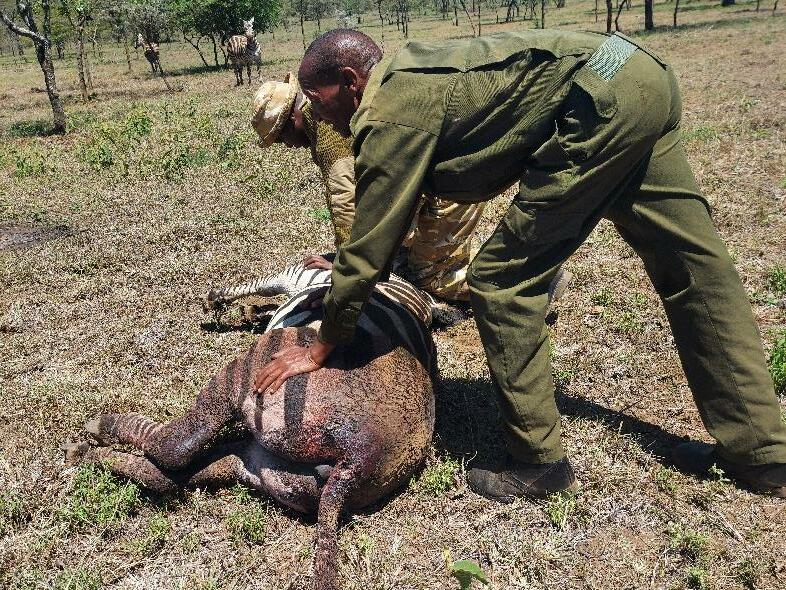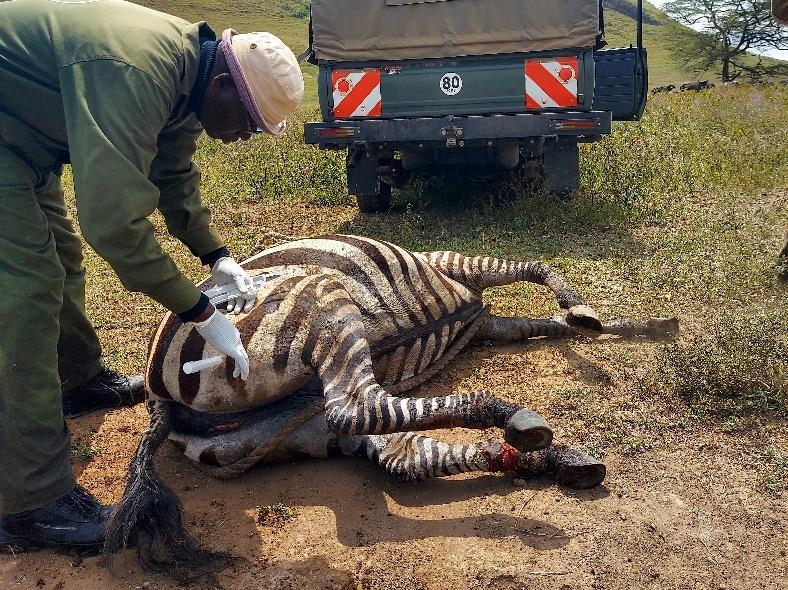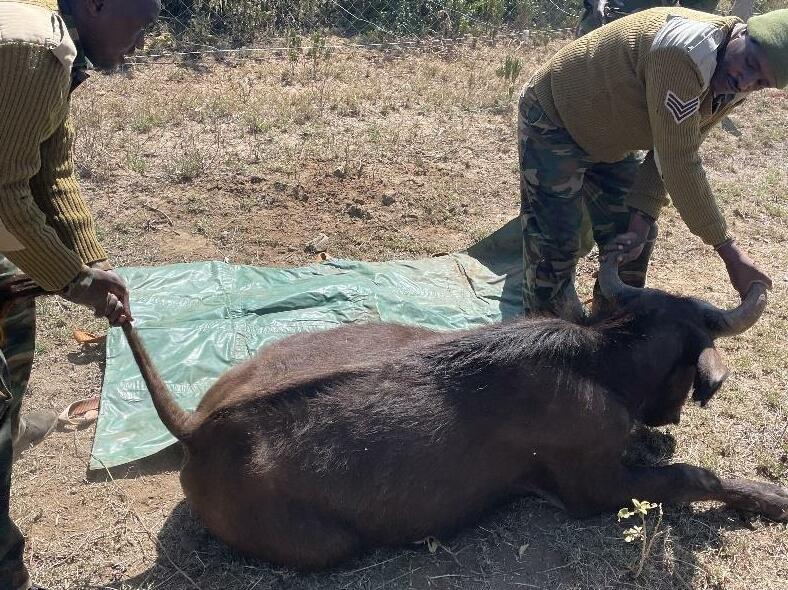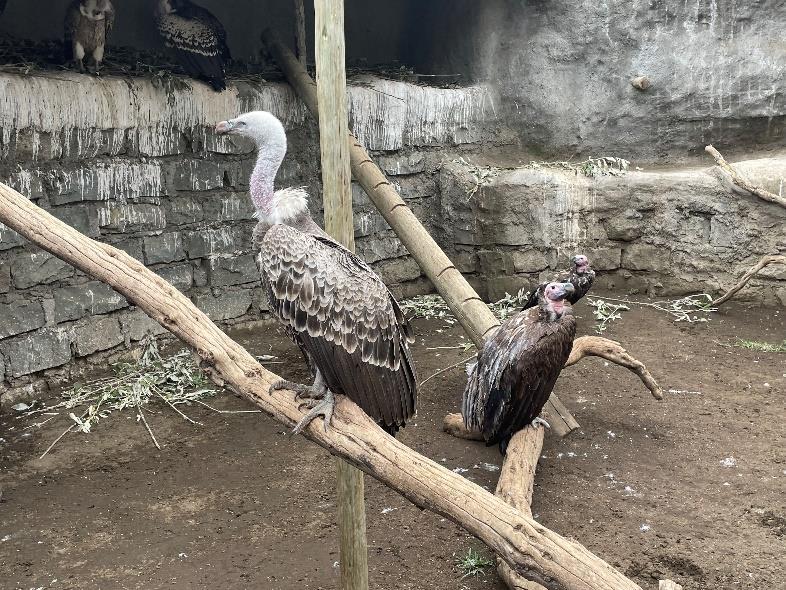







Some rainfall was received during the reporting period in the areas north and south of Lake Naivasha as well as the Central Rift Conservation Area in general. The Rift Valley Mobile Veterinary Unit attended to 11 cases in October, 3 of these cases involved rhinos in Lake Nakuru National Park. 4 cases in total were related to poaching. These involved 3 zebras and 1 giraffe snared by poachers, a 4th zebra was accidentally entangled in fence wires. The Rift Valley Veterinary Unit also translocated a hand raised orphan female buffalo called Pili from Kongoni Game Valley to Aberdare National Park.
We sincerely thank Sheldrick Wildlife Trust (SWT) and FIGS for their support and sponsorship. We also acknowledge Angela Sheldrick, CEO -SWT, for her unwavering support and interest in the work undertaken by the Vet Unit. Additionally, we appreciate Kenya Wildlife Service (KWS) for proving equipment that included the Bell Helicopter used in rhino search & health monitoring as well as facilitating coordination and managerial oversight. We also acknowledge the Wildlife Research & Training Institute (WRTI) for hosting the Rift Valley Mobile Vet Unit at WRTI. We sincerely thank all stakeholders and scouts who reported wildlife in distress. Thank you all.
Date Species Area Found
Reason for Intervention Outcome
02-Oct 22 Rhino Lake Nakuru N.P. Postmortem Male black rhino called Okita found dead Task successful
05-Oct 22 Zebra Maraigushu Area Snared Snared with a nylon rope and wounded on its left hind leg Successfully treated
05-Oct 22 Zebra Kongoni Game Valley Natural Causes Snared with a nylon rope and wounded on its left hind leg Successfully treated
06-Oct 22 Zebra Green Park Natural Causes Zebra stallion wounded during a territorial fight Successfully treated
17-Oct 22 Zebra Kijabe Farm – Moi South Lake Road Snared Male zebra with a long wire snare around the neck Task successful
17-Oct 22 Zebra Kijabe Farm – Moi South Lake Road Snared Female zebra with a long wire snare around the neck Task successful
17-Oct 22 Rhino Lake Nakuru N.P. Natural Causes Assessment of a white rhino injured during a territorial fight Task successful

22-Oct
 21-Oct 22 & 22-Oct 22
Rhino Lake Nakuru N.P. Natural Causes Assessment of a white rhino injured during a territorial fight Task successful.
22 Zebra Lake Nakuru N.P. HWC
Severely injured on the left hindlimb after it accidentally got entangled in fence wires Successfully treated.
23-Oct 22 Giraffe Lentolia Wildlife Conservancy Snared Winch wire snare on the right forelimb Successfully treated
25-Oct 22 Buffalo Kongoni Game Valley Relocation
Translocation of an orphan female buffalo hand raised in Kongoni Game Valley to Aberdare National Park Task successful
21-Oct 22 & 22-Oct 22
Rhino Lake Nakuru N.P. Natural Causes Assessment of a white rhino injured during a territorial fight Task successful.
22 Zebra Lake Nakuru N.P. HWC
Severely injured on the left hindlimb after it accidentally got entangled in fence wires Successfully treated.
23-Oct 22 Giraffe Lentolia Wildlife Conservancy Snared Winch wire snare on the right forelimb Successfully treated
25-Oct 22 Buffalo Kongoni Game Valley Relocation
Translocation of an orphan female buffalo hand raised in Kongoni Game Valley to Aberdare National Park Task successful


Lake Nakuru National Park management reported the death of a male black rhino called Okita that had received treatment for a wounded leg on earlier date
i) The rhino carcass was found lying on left lateral recumbency. The lower and upper horns were intact (present).
ii) The rhinoceros had a poor body condition score of 2.5 where 1 is very poor and 5 is excellent.
iii) The rhino was lying in mud.

iv) The rhino had a chronic wound on the right hind leg.
i) The rhino had not fed for a long time. The colon had scanty ingesta.
ii) The lungs were congested.
iii) The right hind leg had a gangrenous wound which was about 7cm deep.
iv) Muscles on the right hind leg (knee region) had degenerated into a “cooked appearance”
The cause of death of this male black rhino was an ascending infection hence the gradual loss of body condition and muscle wasting. The gangrenous wound was the source of toxins circulating in Okita’s blood.
This case was reported by the Kedong ranch security team. The zebra was darted with 5 mg Etorphine and 50 mg Ketamine. The female zebra had been snared with a nylon rope and wounded on its left hind leg. The snare was removed then the wound was cleaned with water, rinsed with Iodine and sprayed with a fly repellent. 12,000 mg Oxytetracycline and 1,000 mg Phenylbutazone were administered intramuscularly. 6 ml Ivermectin was also given subcutaneously. Anaesthesia was reversed with 75 mg of Diprenorphine given by IV and IM route. The zebra has a good prognosis.



This case was reported by wildlife scouts based in Kongoni Game Valley. The Zebra was darted with 5 mg Etorphine and 50 mg Ketamine. Physical examination revealed that the zebra’s lameness was caused by an injury on the hoof region. 12,000 mg Oxytetracycline and 300 mg Flunixin Meglumine were administered intramuscularly. 5 ml Ivermectin was administered subcutaneously. Anaesthesia was reversed with 75 mg Naltrexone given by IV and IM route. The zebra has a good prognosis.

This case was reported by Green Park security staff. The zebra was darted with 5 mg Etorphine and 50 mg Ketamine. The zebra stallion had been in a territorial fight, it had a wound on its tail which was bleeding at tail swish and additional wounds on the perineum region. The wounds were cleaned with water, rinsed with Iodine and sprayed with a fly repellent. 12,000 mg Oxytetracycline, 300 mg Flunixin Meglumine were administered intramuscularly. 5 ml Ivermectin was also injected subcutaneously. Anaesthesia was then reversed with 75 mg Naltrexone given by IV & IM route. The zebra has a good prognosis.


This case was reported by the Kijabe Farm manager. The Zebra was darted with 5 mg Etorphine and 50 mg Ketamine. The Zebra stallion had a long wire snare around the neck. Fortunately, the snare had not yet wounded the animal. The snare was removed then anaesthesia was reversed with 75 mg Naltrexone given by IV and IM route. The zebra has a good prognosis.


This case was also reported by the Kijabe Farm manager.
The female Zebra was darted with 5 mg Etorphine and 50 mg Ketamine. The Zebra had a long wire snare around the neck. Luckily, the snare had not yet inflicted any injury on the zebra’s neck. The snare was removed then anaesthesia was reversed with 75 mg Naltrexone given by IV and IM route. The zebra has a good prognosis.



On 17.10.2022 the Rift Valley Veterinary Unit responded to a case of a white rhino injured during a territorial fight. The dominant bull (50 W73) was examined. He was in good health. The injured bull (50W89) was not seen. The security team was advised to continue searching for the injured bull

On 21.10.2022 and 22.10.2022, the Rift Valley Mobile Veterinary Unit searched for the injured male white rhino bull (50W89) with the aid of a helicopter. The rhino was found on 22.10.2022 and according to the Veterinarian’s assessment, the rhino had only suffered minor lacerations and bruises. The rhino security team was advised to continued monitoring both males (50W73 & 50W89). The rhino has a good prognosis since it was in good health.


This case was reported by the Senior Warden. The zebra was darted with 5 mg Etorphine and 50 mg Ketamine. The zebra had accidentally got entangled in fence wires which had severed the flexor & extensor tendons on the left hindlimb. The fence wire was removed then the wound was cleaned with water, rinsed with Iodine and sprayed with a fly repellent. 1,500 mg Amoxicillin and 300 mg Phenylbutazone were administered intramuscularly. 5 ml Ivermectin was also injected subcutaneously. Anaesthesia was then reversed with 75 mg Naltrexone given by IV & IM route. The zebra has a guarded prognosis.


This case was reported by Lentolia Wildlife Conservancy Scouts. Immobilisation, examination and treatment
The giraffe was immobilized with 14 mg Etorphine and 50 mg Ketamine. The giraffe had been snared with a winch wire which had inflicted lacerations on the right forelimb. 12,000 mg Oxytetracycline and 1,000 mg Phenylbutazone were administered intramuscularly. Anaesthesia was reversed with 60 mg of Diprenorphine given by IV and IM route.




The giraffe has a good prognosis.
The owner and chief promoter of ARR M/s Margaret requested Kenya Wildlife Service to translocate Pili, an orphan female buffalo hand raised in Kongoni Game Valley, to the wild. She was relocated by the Rift Valley Mobile Veterinary Unit from Kongoni Game Valley to Aberdares NP-Shamata area.



Pili was immobilized with 3 mg Etorphine and 2 mg Medetomidine. While under general anaesthesia, she was then loaded onto a lorry and transported in truck with hay beddings and soil for 164 Km to the released site in Shamata area, Aberdare National Park. Pili was reversed from general anaesthesia with 75 mg Naltrexone and 7.5 mg Atipamizole administered intramuscularly.
The exercise was a success largely due to the co-operation and support from the management and staff of Kongoni Game Valley. We sincerely thank M/s Margaret Zack for providing the lorry used to transport Pili to her new home in the wild.




 On 03rd October 2022 at WRTI-Naivasha, the Veterinarian Participated in Training on Treatment, Handling, and Care of Poisoned Raptors
On 03rd October 2022 at WRTI-Naivasha, the Veterinarian Participated in Training on Treatment, Handling, and Care of Poisoned Raptors
From 18th October 2022 to 20th October 2022 the Veterinarian participated in a workshop held in Kisumu City on Quadripartite Joint Risk Assessment of priority zoonotic diseases in the animal – human - environment interphase of Western cluster of Counties.

The Government of Kenya through the Zoonotic Disease Unit, and in collaboration with FAO - ECTAD, UNEP, WAOH, WHO, OHRECA-ILRI and Washington State University operationalized the Joint Risk Assessment (JRA) at sub-national level in Kenya. The participants carried out a joint risk assessment for Busia County – Ebola Viral Disease, Kakamega County – Anthrax, Bugoma County – HPAI, and Vihiga – Rabies. The workshop was supported by USAID (Kenya) under the Global Health Security Agenda to address zoonotic diseases in Africa.
On 27th October 2022, the RiftValley Mobile Veterinary Unit held a planning and budgeting meeting at Loldia Farm for the intended translocation of Masai giraffes.
The translocation exercise had been approved by Kenya Wildlife service management. The meeting was chaired by the Senior Warden - Hells Gate National Park, members present included the Warden Crime, the Resident Vet, Mildred Achieng and Honorary Wardens - Ronaldo Retief and Gary Hoffcraft.